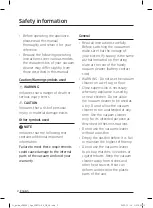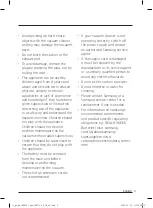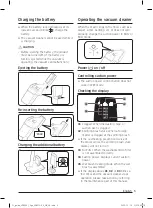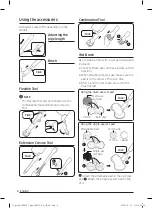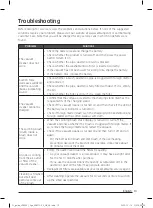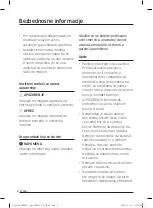
English
10
• If the battery is removed while
the vacuum cleaner motor is
operating, the battery may not
work for 30 seconds after being
re-attached for safety reasons.
• Battery charging time and usage
time may shorten with increased
battery use. When the battery
no longer charges or runs down
quickly, replace the exhausted
battery with a new one.
• Use only the charging stand
and batteries provided by the
manufacturer.
• Before inserting the battery,
confirm that the battery is being
inserted in the correct direction
and orientation.
• When discarding a dead battery,
put it into a battery collection box
for recycling.
• If you are not going to use your
vacuum cleaner for a long time,
detach the battery from the
vacuum.
• When attaching the battery to the
vacuum, insert it until you hear a
click. This assures that the battery
is firmly attached.
– Otherwise, the battery may fall
and could cause product damage
or injury.
• Do not drop or strike the battery
or subject it to a sudden shock.
• Do not disassemble the battery
and make sure that you do not
create a short circuit across the
plus (+) and minus (-) terminals.
• Leaks from battery cells can
occur under extreme usage or
temperature conditions. If the
liquid gets on your skin, wash
the affected area quickly with
water. If the liquid gets into your
eyes, flush them immediately
with clean water for a minimum
of 10 minutes. Seek medical
attention.
• To protect the motor and battery,
the vacuum cleaner may not
operate when the temperature
is lower than 5 °C or higher than
45 °C.
Operation
NOTE
• If excessive force is applied to a
brush or foreign matter is caught
in the spinning brush (drum),
the brush may stop working to
protect the motor or vacuum.
Turn the vacuum off, remove the
foreign matter, and then turn the
vacuum on. If the vacuum does
not start, turn it off and then on
again.
Q_guide_VS9000_13ge_00821J-04_GE_A5.indb 10
2020-12-14 오후 5:56:02


